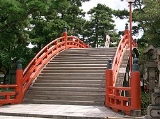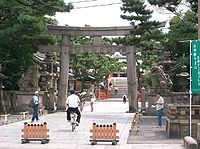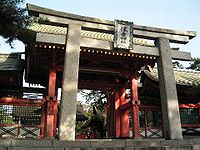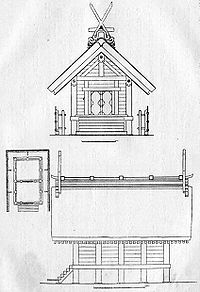
Sumiyoshi Taisha
Encyclopedia


Shinto
or Shintoism, also kami-no-michi, is the indigenous spirituality of Japan and the Japanese people. It is a set of practices, to be carried out diligently, to establish a connection between present day Japan and its ancient past. Shinto practices were first recorded and codified in the written...
shrine
Jinja (Shinto)
A Shinto shrine is a structure whose main purpose is to house one or more Shinto kami....
in Sumiyoshi
Sumiyoshi-ku, Osaka
is one of 24 wards of Osaka, Japan. It is located on the southern part of the Uemachi Plateau, in the southern most part of Osaka City, and is separated from Sakai City's Sakai-ku and Kita-ku by the Yamato River...
ward in the city of Osaka
Osaka
is a city in the Kansai region of Japan's main island of Honshu, a designated city under the Local Autonomy Law, the capital city of Osaka Prefecture and also the biggest part of Keihanshin area, which is represented by three major cities of Japan, Kyoto, Osaka and Kobe...
, Japan
Japan
Japan is an island nation in East Asia. Located in the Pacific Ocean, it lies to the east of the Sea of Japan, China, North Korea, South Korea and Russia, stretching from the Sea of Okhotsk in the north to the East China Sea and Taiwan in the south...
. It is the main shrine of all the Sumiyoshi shrines in Japan. However, the oldest shrine that enshrines the Sumiyoshi sanjin
Sumiyoshi Sanjin
is the generic name for the three Shinto gods Sokotsutsu no O no Mikoto , Nakatsutsu no O no Mikoto , and Uwatsutsu no O no Mikoto . The Sumiyoshi sanjin are regarded as the gods of the sea and sailing...
, the three Sumiyoshi kami
Kami
is the Japanese word for the spirits, natural forces, or essence in the Shinto faith. Although the word is sometimes translated as "god" or "deity", some Shinto scholars argue that such a translation can cause a misunderstanding of the term...
, is the Sumiyoshi shrine in Hakata
Hakata
Hakata may refer to:*Hakata-ku, Fukuoka, a ward in Fukuoka Prefecture, Japan.**Hakata ningyō , traditional Japanese clay dolls, originally from Hakata*Hakata Station, a large train station in Fukuoka...
.
It is called "Sumiyoshi-san" or "Sumiyossan" by the locals, and is famous for the large crowds that come to the shrine on New Year's Day for hatsumōde
Hatsumode
is the first shrine visit of the New Year in Japan. Some people visit a Buddhist temple instead. Many visit on the first, second, or third day of the year as most are off work on those days. Generally, wishes for the new year are made, new o-mamori are bought, and the old ones are returned to the...
.
Sumiyoshi taisha enshrines the Sumiyoshi tanjin -- Sokotsutsu no Onomikoto, Nakatsutsu no Onomikoto, and Uwatsutsu no Onomikoto -- and Okinagatarashihime no Mikoto (Empress Jingū), and they are collectively known as the "Sumiyoshi Ōkami", the great gods of Sumiyoshi. Another term is "Sumiyoshi no Ōgami no Miya".
It gives its name to a style of shrine architecture
Shinto architecture
Shinto architecture is the architecture of Japanese Shinto shrines.With a few exceptions, the general blueprint of a Shinto shrine is Buddhist in origin. Before Buddhism, shrines were just temporary structures erected to a particular purpose. Buddhism brought to Japan the idea of permanent shrines...
known as Sumiyoshi-zukuri
Sumiyoshi-zukuri
is an ancient Shinto shrine architectural style which takes its name from Sumiyoshi Taisha's honden in Ōsaka. As in the case of the taisha-zukuri and shinmei-zukuri styles, its birth predates the arrival in Japan of Buddhism.-History:...
.
History
The shrine became the object of Imperial patronage during the early Heian periodHeian period
The is the last division of classical Japanese history, running from 794 to 1185. The period is named after the capital city of Heian-kyō, or modern Kyōto. It is the period in Japanese history when Buddhism, Taoism and other Chinese influences were at their height...
. In 965, Emperor Murakami
Emperor Murakami
was the 62nd emperor of Japan, according to the traditional order of succession.Murakami's reign spanned the years from 946 to his death in 967.-Traditional narrative:...
ordered that Imperial messengers were sent to report important events to the guardian kami of Japan. These heihaku were initially presented to 16 shrines including Sumiyoshi.
Sumiyoshi was designated as the chief Shinto shrine (ichinomiya) for the former Settsu province
Settsu Province
was a province of Japan, which today comprises the eastern part of Hyōgo Prefecture and the northern part of Osaka Prefecture. It was also referred to as or .Osaka and Osaka Castle were the main center of the province.-History:...
.
From 1871 through 1946, Sumiyoshi taisha was officially designated one of the , meaning that it stood in the first rank of government supported shrines.
The Sumiyoshi kami and Empress Jingū
Sumiyoshi taisha was founded by Tamomi no Sukune in the 9th year of Emperor ChūaiEmperor Chuai
; also known as Tarashinakatsuhiko no Sumeramikoto; was the 14th emperor of Japan, according to the traditional order of succession.No firm dates can be assigned to this emperor's life or reign, but he is conventionally considered to have reigned from 192–200....
's reign (year 211
211
Year 211 was a common year starting on Tuesday of the Julian calendar. At the time, it was known as the Year of the Consulship of Terentius and Bassus...
http://www.sumiyoshitaisha.net/outline/history.html). A member of a powerful family in the area, he was given the clan name of Owari by Empress Jingū, when she visited the coast of the Gokishichidō
Gokishichido
was the name for ancient administrative units organized in Japan during the Asuka Period , as part of a legal and governmental system borrowed from the Chinese...
(Modern Shichidou in Sakai, Osaka
Sakai, Osaka
is a city in Osaka Prefecture, Japan. It has been one of the largest and most important seaports of Japan since the Medieval era.Following the February 2005 annexation of the town of Mihara, from Minamikawachi District, the city has grown further and is now the fourteenth most populous city in...
) after her return from her invasion of Korea. At the same time, she told him to enshrine the Sumiyoshi sanjin, as she had been told to do so by an oracle. Later, the empress herself was also enshrined at Sumiyoshi. The Tsumori clan, whose members have succeeded the position of head priest of Sumiyoshi taisha since the reign of Emperor Ōjin
Emperor Ojin
, also known as Homutawake or , was the 15th emperor of Japan, according to the traditional order of succession.No firm dates can be assigned to this emperor's life or reign, but he is conventionally considered to have reigned from 270 to 310....
, are the descendants of Tamomi no Sukune's son, Tsumori no Toyoada (or Tsumori no Toyonogodan).
Other kami
Sumiyoshi taisha is also regarded as the ancestor shrine of HachimanHachiman
In Japanese mythology, is the Japanese syncretic god of archery and war, incorporating elements from both Shinto and Buddhism. Although often called the god of war, he is more correctly defined as the tutelary god of warriors. He is also divine protector of Japan and the Japanese people...
shin, the god of war, as the taisha enshrines Empress Jingū, who was the mother of Emperor Ōjin, who was deified as Hachiman. Therefore, the shrine is guardian of the Kawachi Dynasty. Also, Hachimanshin is the god of war on land, and the Sumiyoshi gods are the gods of war on the sea. Later, Sumiyoshi taisha became one of the three kami of waka
Waka (poetry)
Waka or Yamato uta is a genre of classical Japanese verse and one of the major genres of Japanese literature...
.
Yamato Diplomacy and the Silk Road
The Taisha is a shrine with connections to the ancient Yamato royalty's diplomacy and sailing, protecting the Imperial embassies to ChinaImperial embassies to China
The Japanese Missions to Imperial China were diplomatic embassies which were intermittently sent to the Chinese court. Any distinction amongst diplomatic envoys sent from the Imperial Japanese court or from any of the Japanese shogunates was lost or rendered moot when the ambassador was received in...
. As the head priests, the Tsumori clan also boarded these embassy ships. The embassies departed from Suminoe no Tsu
Suminoe no Tsu
Suminoe no Tsu is the oldest international port in Japan.Said to be opened by Emperor Nintoku, Suminoe no Tsu was located on an inlet called Suminoe no Hosoe on the southern side of Sumiyoshi Grand Shrine, in the south of current day Osaka city...
, a port on the Hosoe-gawa (also known as Hosoi-gawa. Known as Suminoe no Hosoe in ancient times), a river located to the south of the shrine. Suminoe no Tsu is the oldest international port in Japan, and was opened by Emperor Nintoku
Emperor Nintoku
was the 16th emperor of Japan, according to the traditional order of succession.No firm dates can be assigned to this emperor's life or reign, but he is conventionally considered to have reigned from 313–399.-Legendary narrative:...
. It was the Silk Road
Silk Road
The Silk Road or Silk Route refers to a historical network of interlinking trade routes across the Afro-Eurasian landmass that connected East, South, and Western Asia with the Mediterranean and European world, as well as parts of North and East Africa...
's entrance into Japan.
In The Tale of Genji
Although Sumiyoshi taisha is currently completely landlocked, until the Edo periodEdo period
The , or , is a division of Japanese history which was ruled by the shoguns of the Tokugawa family, running from 1603 to 1868. The political entity of this period was the Tokugawa shogunate....
, the shrine riding grounds (currently Sumiyoshi Park
Sumiyoshi Park
Sumiyoshi Park is an Osaka prefectural park in Hamaguchi-higashi Itchome, Suminoe-ku, Osaka, Japan.It was registered by Osaka Prefecture in 1873 with Hamadera Park in Nishi-ku, Sakai, and is the oldest park in Osaka.-Access:...
) faced the sea, and was considered the representative of the beautiful "hakushaseishou" (white sand and green pines) landscape. So much so that this type of scenery in designs and art is known as the Sumiyoshi design. In Murasaki Shikibu
Murasaki Shikibu
Murasaki Shikibu was a Japanese novelist, poet and lady-in-waiting at the Imperial court during the Heian period. She is best known as the author of The Tale of Genji, written in Japanese between about 1000 and 1012...
's The Tale of Genji
The Tale of Genji
is a classic work of Japanese literature attributed to the Japanese noblewoman Murasaki Shikibu in the early 11th century, around the peak of the Heian period. It is sometimes called the world's first novel, the first modern novel, the first psychological novel or the first novel still to be...
, the shrine is used as an important stage in some chapters concerning the Akashi Lady.
Also, in the folktale "Issun-bōshi", an old couple who had not been blessed with children prayed at Sumiyoshi taisha. Their prayers were granted, and when the child went on a voyage, he departed at Sumiyoshi harbor, sailed down Hosoe-gawa to Osaka Bay
Osaka Bay
Osaka Bay is a bay in western Japan. As an eastern part of the Inland Sea, it is separated from the Pacific Ocean by the Kii Channel and from the neighbor western part of the Inland Sea by the Akashi Strait...
, sailed up the Yodo River, and entered Kyoto
Kyoto
is a city in the central part of the island of Honshū, Japan. It has a population close to 1.5 million. Formerly the imperial capital of Japan, it is now the capital of Kyoto Prefecture, as well as a major part of the Osaka-Kobe-Kyoto metropolitan area.-History:...
.
Construction style

Honden
The , is the most sacred building at a Shinto shrine, intended purely for the use of the enshrined kami, usually symbolized by a mirror or sometimes by a statue. The building is normally in the rear of the shrine and closed to the general public. In front of its usually stands the haiden, or...
is built in the Sumiyoshi-zukuri
Sumiyoshi-zukuri
is an ancient Shinto shrine architectural style which takes its name from Sumiyoshi Taisha's honden in Ōsaka. As in the case of the taisha-zukuri and shinmei-zukuri styles, its birth predates the arrival in Japan of Buddhism.-History:...
style and has been designated
a national treasure
National treasures of Japan
National Treasures are the most precious of Japan's Tangible Cultural Properties, as determined and designated by the Agency for Cultural Affairs...
on the grounds that it is the oldest example of this style of architecture.
There is an okichigi
Chigi (architecture)
, or are forked roof finials found in Japanese and Shinto Architecture. Chigi predate Buddhist influence and are an architectural element endemic to Japan. They are an important aesthetic aspect of Shinto shrines, where they are often paired with katsuogi, another type of roof ornamentation...
(置千木) a forked finial
Finial
The finial is an architectural device, typically carved in stone and employed decoratively to emphasize the apex of a gable or any of various distinctive ornaments at the top, end, or corner of a building or structure. Smaller finials can be used as a decorative ornament on the ends of curtain rods...
, on the roof of the main shrine, as well as 5 square katsuogi
Katsuogi
or are short, decorative logs found on Japanese and Shinto architecture. They are placed at a right angle along the ridge of roofs, and are usually featured in religious or imperial architecture. Katsuogi predate Buddhist influence and is an architectural element endemic to Japan. They are...
(堅魚木), billets placed horizontally along the length of the roof.http://www.aisf.or.jp/~jaanus/deta/k/katsuogi.htm There are no corridors around the sanctuary. It is surrounded by a plank tamagaki
Tamagaki
A is a fence surrounding a Japanese Shinto shrine, a sacred area or an imperial palace. Believed to have been initially just a brushwood barrier of trees, tamagaki have since been made of a variety of materials including wood, stone and — in recent years — concrete...
fence (玉垣), which is further surrounded by an ara-imi fence (荒忌垣).
The pillars are round, and stand on stone foundations. The planks between the pillars are horizontal. The area seen from front is the nave, and beyond is the inner shrine and second room.
Sumiyoshi Torii
One of the stone toriiTorii
A is a traditional Japanese gate most commonly found at the entrance of or within a Shinto shrine, where it symbolically marks the transition from the profane to the sacred...
at the shrine is known as the Kakutorii (角鳥居). It is unusual in that the middle bar does not extend outside of the vertical posts, and all pieces have square edges. The torii at the shrine's main entrance (see photo above) is similar in structure. This type of torii is called Sumiyoshi torii after the shrine.
See also
- List of Shinto shrines
- Twenty-Two Shrines
- Modern system of ranked Shinto ShrinesModern system of ranked Shinto ShrinesThe The The (sometimes called simply , was an organizational aspect of the establishment of Japanese State Shinto. This system classified Shinto shrines as either official government shrines or "other" shrines...
External links
- http://www.sho-shin.com/sai6.htm

